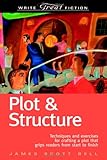Review: Plot and Structure, James Scott Bell
Do you find that when you start a piece of writing you are sure of your plot and structure of your story? Do you find that after a only a few chapters (or paragraphs!) you are writing another story altogether? If any of this sounds familiar, this article is for you.
When I first started to become a writer a problem I ran into was that the first three sections in a piece were just great, but over time the story started to wander. This issue would tend to magnify in relation to the length of the piece of work. I needed advice from a professional writer, or instructor, but I didn’t know any.
The problem, at least in part, was that although I thought I knew what I was setting out to write my actual conception of the overall plot was weak. I knew the end I wanted and many of the plot points along the way, but as soon as the story started my writing seem to go on to wander a path all of its own.
In short, I needed a system.
Plot and Structure

Well, one of the first books I bought in this area was “Plot and Structure” by James Scott Bell.
It is no exaggeration to say that when I read this book I thought I had discovered the “Holy Grail” of writing books (yes, I was a newbie). Plot and Structure suddenly illuminated areas of the writing process I had never even considered.
For instance, are you a NOP or an OP kind or person? It is ok to be confused by those words, they are terms from the book. An OP is an “outline person” and a NOP is a “no outline person”. Mr Bell shows how plotting can still be relevant even if you are a NOP kind of person.
Plot and Structure deals with the usual beginnings, middles and ends of a story but it goes a lot further. The book also deals with techniques for tightening tension and increasing interest, developing characters through plot events, motifs, themes, dialogue and also suggestions on how to generate new plot ideas.
An interesting technique that Mr Bell illustrates for developing plot is the “LOCK” system. This stands for Lead, Objective, Confrontation and Knockout. This acronym is well developed in the book and makes for a very useful addition to the aspiring writers’ toolkit.
Plot and structure gives a brief tour of everything you might need to gain a basic knowledge of writing a longer piece of work. Obviously within 230 pages or so these topics cannot be dealt with in great depth, but this takes nothing away from the book.
It is a great book and one that I learned a great deal from. I can recommend it without reservation for anyone that is having trouble with plot and structure.
Dave Felton.

4 Responses to Review: Plot and Structure, James Scott Bell